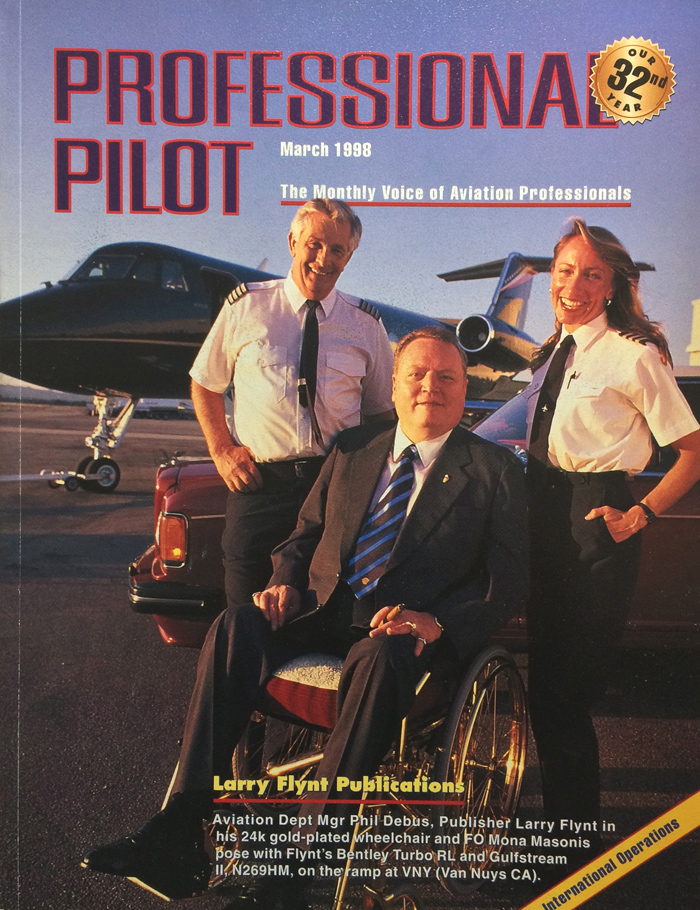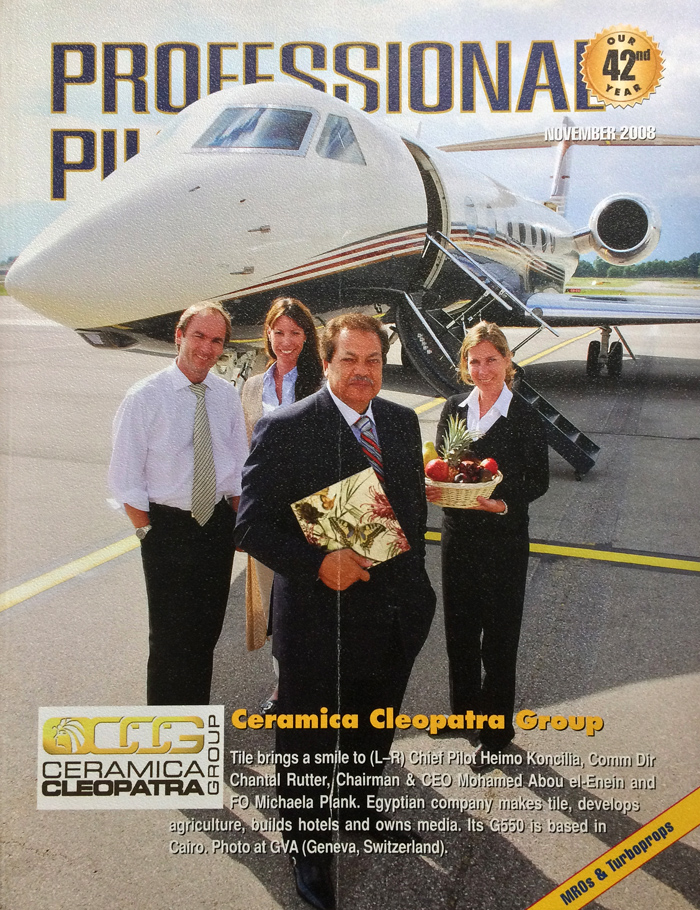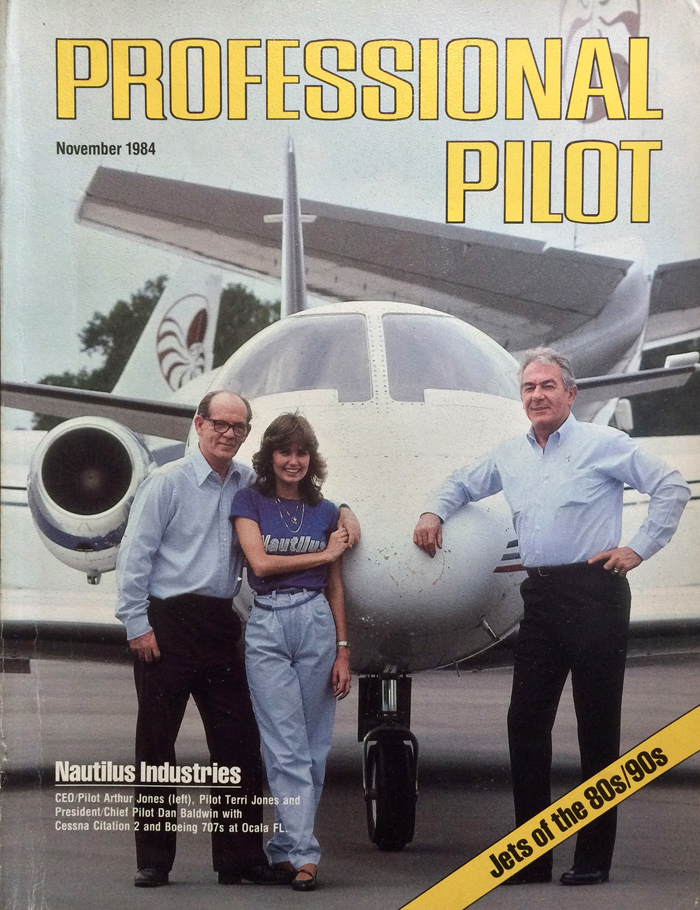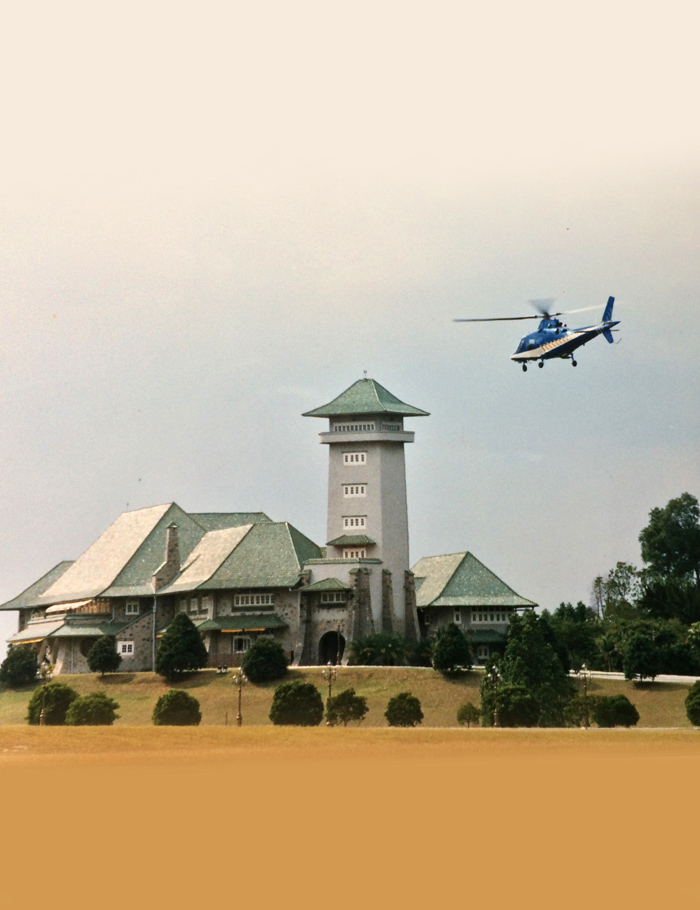Marketing wine and a global law business at Mach .92 with a Citation X
By Grant McLaren
Professional Pilot Magazine January 1999
Sixty-five miles north of San Francisco, in the ruggedly beautiful rolling hills of Sonoma County, is Frederick P. Furth’s world. After winding through country roads, and turning right at a eucalyptus grove, you pass through a large iron gate and into the 1200-acre Chalk Hill estate vineyards and winery. The Chardonnays, Merlots and Pinot Gris from Chalk Hill have become so world renowned that the Queen of England chose the 1994 Chardonnay for her garden party celebrating the 50th anniversary of the end of World War II and sons and daughters of French winemakers are routinely dispatched here for internships.

Chalk Hill President and CEO Fred Furth is also a practicing lawyer.
Furth uses a Cessna Citation X to support operations of his 80,000 case a year winery on missions ranging from a 350 nm hop down to the Hearst Castle near SBP (San Luis Obispo) for a wine distributors meeting to airborne expeditions to Bordeaux France and Beijing China. Corporate aircraft are also instrumental to Furth’s second passion, international law and arbitration work. In the first half of this year the X made four trips to Italy on a big arbitration and about half of the flight department’s total operational requirements are in support of Furth’s globally-scattered clientele. While Furth’s Citation X displays Chalk Hill logos on each of its big Rolls Royce AE3007C nacelles it might just as well bear depiction’s of Themis — the blindfolded Goddess of Justice — as missions are equally divided between wine and the law.
“I want to make the finest wine in the world, I want to give my law clients the best representation they can get in the world and I want to run my flight department as the best, and the safest, in the world,” declared Furth from his command post atop Chalk Hill. “Corporate aircraft have become indispensable to me — they give me the ability to do business all over the world.”
The Chalk Hill flight department is a compact, efficient affair. Aviation Manager Mark Dietrick manages operations, and is responsible for aircraft maintenance out of the corporate hangar at STS (Santa Rosa CA), while Capt Tim Yaeger flies right seat in the X for his boss who pilots flights from the left seat.
Wine and the Law
Having trained to fly while in the Army Furth rented a plane from the Santa Rosa Air Center back in the early 70’s to scout for land in the Napa Valley and Sonoma County. He spotted a hilly, rugged area in Sonoma County that appealed to him and in 1972 he purchased the land — 242 acres, the founding parcel of the Chalk Hill Estate.
Over the years the capabilities of the flight department evolved — from a Beech Bonanza to a Baron to a King Air F90 to a Rockwell Sabre 40 which Furth acquired in 1981 to traverse the world.
“We had the nicest Sabre 40 you can imagine and one of only two silver editions that was done in the early 80s. It had a Collins EFIS panel, zero timed engines and every conceivable mod and upgrade you could put in it,” recalled Dietrick.
A Sabre 65 replaced the 40 in 1988 and maintained a 400 hour per year global schedule for its nine years on the flightline. In September of 1997 Furth moved up to the Citation X to support an increasingly global law practice and wine distribution network.

Fred Furth leaves Napa Valley wine country in his Citation Xjet to make a quick legal presentation in Brewton, Alabama.
“The Citation X is one of my most important tools as a lawyer and as a vintner and its performance has been even better that I’d expected,” observed Furth who has not flown the commercial airlines in 15 years. “Cutting an hour to an hour and a half off here and there makes a big difference in my productivity and willingness to make a trip. With a Mach .88 to Mach .92 cruise speed you can leave later and get there earlier which is especially important to an owner pilot when you have to work at the other end.”
So cost effective is the Citation X, as compared with the smaller Sabre 65, that flight department DOCs have hardly budged with the step-up to the close-to-supersonic 35,700 lb MTOW business transport.
“Our DOCs are really no higher on the X,” confirmed Yaeger. “At midweight, and at Mach .87 – .88, we’re seeing fuel burns of 1610 – 1660 lbs compared to 1450 lbs on the Sabre at Mach .78. Overall costs of operating a Citation X are really no more than the Sabre when you take everything into account.
Chalk Hill’s flight department has all the tools necessary to run a first class corporate flight operation. A new 14,000 sq foot hangar at STS, especially built for the Citation X, is fully equipped to support Cessna’s top-of-the-line product and there’s a dedicated flight ops planning/training center amid the vineyards of Chalk Hill. The upper level of a garage, immediately above Furth’s Citation X-decalled red Rolls Royce, is a fully computerized flight planning and chart room where round-the-world trips are orchestrated.
Owner Pilot Flight Department
Furth and Yaeger attend FlightSafety recurrent training in Wichita annually and run every facet of their flight operation in a top-notch, professional, manner.
Furth recalled that his initial transition to the Citation X required a certain dedication.
“Making the transition required a lot of thought and attention. The cruise speeds and cruise altitudes are so much higher, you’ve got sweeps on the wing, and the tail, similar to a B747 and the Honeywell Primus 2000 EFIS system is much more sophisticated than the Collins systems we had on the Sabre 40 and 65.”
For Yaeger the transition to the Citation X was both challenging and enjoyable.
“The initial training wasn’t too bad but there were some different characteristics to adjust to on landing and the Citation X’s roll control still needs a little work. Overall, however, the X is a great airplane. I like the its speed and altitude capabilities and it’s a very stable aircraft in turbulence.”
Situational Awareness is a key concern with this flight operation and SOP is to study topographical charts prior to international trips and to carry topographical back-up charts on all overseas operations.
“We carefully study all alternates and local topography before going on trips,” explained Furth. “I remember going into Crete one day and being put in a holding pattern I knew was too low from the VFR charts I’d studied in advance. You’ve got to maintain good situational awareness, and crew coordination, at all times.”
Furth believes the skills he’s gained as a pilot help him in all facets of his life.
“Being a pilot adds a new dimension to your life as well as a certain amount of discipline. Emotionally, it gives you an element of control which makes you a better lawyer, vintner and overall person. Flying the aircraft keeps me alert and I’m ready to handle complex legal cases when I land. Even my wife sees an entirely different personality come out when I go flying.”
For Yaeger, who worked night freighters and flew corporate in Saudi Arabia previously, flying with an owner has definite pluses.
“It’s a little harder in that you don’t have someone to share the duties with in terms of preparing the aircraft for a trip or putting it to bed. On the other hand, flying the way we do is nice. We tend to fly for a week and then stay home for a week and we don’t take many short notice trips.”
Dietrick, who’s been with Furth over 12 years, has been given a straightforward mandate from the boss. “I want my jet maintained as the best maintained jet in the world,” declared Furth. “Someone has to have the #1 maintained jet in the world and I want mine to be that aircraft.”
Dietrick enjoys a close association with the owner.
“It’s an interesting relationship — there’s nowhere to hide for me and Fred’s the immediate judge of how successful we are. He demands excellence but he’s willing to support us 100%. If we can justify an expense in our own minds then it’s fine by him.”
Both Dietrick and Yaeger are paid well for their services and enjoy enviable lifestyles in the attractive environs of northern California. Dietrick lives 10 minutes north of the hangar near a clear blue mountain lake while Yaeger raises quarter horses on his ranch in the San Joaquin valley when not flying.
Selecting the X
Furth considered both the IAI Astra SPX and the Falcon 50EX before making the decision to acquire a Citation X last year.
“I’d given serious consideration to buying either an Astra SPX or a Falcon 50EX but the Citation X had a bigger cabin than the Astra and a speed advantage over the 50EX. Cessna had kept me up to date on the program over the prior three years and I was intrigued by the fact that this was going to be an all-new aircraft and that I’d be among an elite group of aviators to fly at supersonic, or near supersonic, speed.”
Since taking delivery of his Mach .92 transport in September 1997 Furth has not looked back.
“I’d studied the X and I had a good idea of its performance characteristics but I couldn’t believe how fast and reliable it turned out to be. The Sabre 65 had a max cruise of Mach .83 but we’d usually be down at Mach .76 in long range cruise. On the X, however, we never cruise less than Mach .85. You can try to pull this aircraft back to Mach .82 but it doesn’t like it and it just doesn’t seem to fly as well at slower speeds.”
On transcon flights at Mach .88 to .90, and FL490-510, Furth does not hesitate to get on the radio to talk with pilots maneuvering jets one to two miles below. He’ll give them an update on the clear weather conditions at FL510 before explaining that, as he’s flying at Mach .90, he’ll soon be out of radio range.
The size, and elegant lines, of the Citation X is no doubt also a plus in legal posturing. When Furth pulls up at an airport in his big, highly aerodynamic, transport alongside opposing attorneys, who typically arrive in smaller Citations, Lears or aboard airlines, they perhaps sense they’re up against a successful and formidable opponent.
The Citation X enhances Furth’s commitment to personal business making it practical to launch out-and-back day trips to the East coast or three day, multi-stop, missions to China or Europe.
“Personal business, and being there on the scene, is tremendously important in international law and winery work,” explained Furth. “If your client gets sued in a foreign country, for example, the first thing you do is get up and go there — otherwise you’re in big trouble.”
Operations at Mach .90
With a 3250-nm 6 hr and 45 min range (longrange cruise with IFR reserves) the X makes Hawaii against all headwinds, it’s an all-year transcon machine at Mach .88 and it’ll reach most of Europe with one stop. Although STS’s runway is a little on the short side, at 5100 feet, the Citation X will still make it to New York with sufficient fuel and a light passenger load even on a hot day.
The ideal procedure for longrange cruise, according to Furth, is to climb direct to FL 410, 430 or 450 at 275 kts to Mach .83 and then level to build speed to Mach .865 before requesting a block of airspace and commencing a high speed gradual climb.
“When you get to FL490 your going to be lighter and you’ll typically be going Mach .88 at a total fuel burn as low as 1400 lbs. When the aircraft lightens up later in the flight you’ll get up to Mach .90-.92 and, on occasion, FL510. For a short flight, with a light fuel load, we’ll climb to FL390 and fly at Mach .90.”
Cessna’s five year bumper-to-bumper warranty on the Citation X covers just about everything and very little is required beyond warranty obligations explained Dietrick.
“The Citation X is easy to support and managing a 450 hour annual flight schedule is totally doable as a one-person maintenance operation. The aircraft’s reliability has exceeded my expectations and the Citation X’s inspection program is surprisingly flexible.”
Maintenance capabilities out of the STS hangar include everything short of major structural work and the operation is completely tooled from a technical standpoint. Reliability of the X has been such than only one trip, out of 188 trips to date, has been canceled for technical reasons. Product support from Cessna’s dedicated 24-hour “Team X” desk has been superb, noted Dietrick, and overall maintenance workload has turned out to be even less than with the smaller Sabre 65.
“The Sabre 65 was a well-honed machine and an easy aircraft to maintain but the Citation X, despite its size, is the easier of the two from a maintenance, and parts availability, standpoint.”
Dietrick estimates that the cost of running a stand-alone 450-hour annual Citation X operations works out to be about $1443 per flight hour or some $650,000 on an annual basis. While this figure does not include capital costs or depreciation it encompasses everything from wages, hotels, catering and handling fees to insurance, hangar and repairs. Average fuel cost for this flight department run a fairly reasonable $1.85 a gallon but the real shocker, in terms of costs, has turned out to be user fees when operating overseas.
The secret to running a cost-effective flight department, according to Dietrick, is to “determine the level of safety first — which is a goal that never changes — and then to go about running the flight department in the most cost effective manner in order to get the most bang for the buck.”
This occasionally means tankering fuel, accessing fuel farms and negotiating on international handling charges. Safety and comfort, however, are never compromised in this flight department and passengers enjoy vintage Chalk Hills wines as well as hot meals aloft featuring fresh cod from Iceland, fresh salmon out of Anchorage and assorted Asian delicacies when the aircraft is in that part of the world.
Flying to Brewton
When Pro Pilot went to visit Chalk Hill a short-notice trip came up — Furth had to be in rural Alabama the next day to meet with a local judge — and we were invited along. Up in his chart room, above the garage, Furth determined that the closest strip to the judge was 12J (Brewton AL) which had a nice 5135 ft runway.
A 3 pm departure out of STS took us direct to FL430 and an initial cruise speed of Mach .86. We encountered significant thunderheads over the Rockies, with swaths of red coming up on the radar, and at FL490 had to make a slight cautionary diversion while corporate jets and airliners far below us were re-routing all over the place. Late in the flight we’d achieved a Mach .90 cruise speed at FL490. Furth demonstrated a Mach .92 descent into Brewton which gave us an elapsed time of just three hours and twenty nine minutes.
While this out-of-the-way airfield had no center point fueling capabilities, virtually no ground transport availability and a little airport dog which kept trying to relieve itself on the Citation Xs tires, the effectiveness of corporate aviation was once again demonstrated. Brewton, a tiny town located on a rail line between the Burnt Corn and the Murder Creeks, has no commercial air service and it would have been a double or triple airline connection, with a long rental car drive tacked onto it, had the corporate aviation option not been exercised.
Future directions
With a growing legal and wine business Furth anticipates topping 500 flight hours this year and the Citation X’s first around-the-world is already on the planning boards. Furth has ambitions of creating a vineyard from scratch in the Bordeaux region of France “in the American style and to American standards.” He’s also interested in establishing vineyards and wineries in China as this part of the world holds great long-term potential.
This flight department has no interest in moving-up to a Global Express, Gulfstream V or Falcon 900 as passenger loads are typically light. While Furth values the attributes of speed he’s a little skeptical about the near-term availability of a practical supersonic business jet.
“There will be some technical problems with SSBJs,” predicted Furth. “The noise problems can probably be solved but I worry about the kind of worldwide support system you’d need for a relatively small fleet of aircraft like that.”
For the foreseeable future the Citation X will remain Furth’s number one business tool in managing his world.
“Fred couldn’t maintain the productivity level he runs today without a corporate jet.” observed Dietrick. “It’s literally become beyond his scope of reality not to have an aircraft.”





